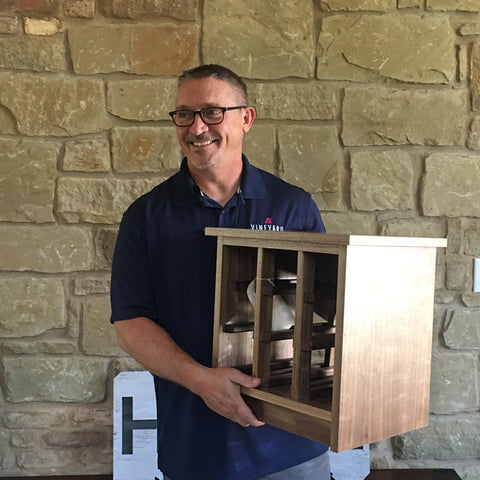For any wine enthusiast, preserving the life of their wine collection is of utmost importance.
A factor that can often go overlooked is the humidity levels in the wine cellar.
Humidity levels that are too high, or even too low, can cause damaging effects to your prized collection.
So, what can you do to lower the humidity levels in your wine cellar?
What's the Best Wine Cellar Humidity?
The best humidity levels for storing wine in your cellar is between 50% and 70%, with an ideal temperature of around 55F.
With low humidity levels, natural materials such as cork can dry out and begin to shrink. A shrunken cork will allow air into the bottle, spoiling the contents within.
High humidity levels allow for the growth of mold and odors. Mould can spoil both the bottle labels and the cork, and odors can impact the quality of the wine.
4 Ways to Lower the Humidity in Your Wine Cellar
1. Install a Cooling System
A high-quality wine cellar cooling system is the best option, as they manage both the humidity and temperature of the space in which they are installed. The temperature and humidity levels inside a cellar can fluctuate with changing natural temperatures. With a cooling system installed, the user can set the ideal range and trust it will stay there. The system will then work independently to keep levels steady and consistent by cycling warm air through its compressor, reducing heat and humidity.There are a number of factors to consider when choosing the best type of cooling unit for your cellar. Buyers need to consider the size of their cellar and the unique variables that can affect its temperature. They should also consider the amount of space and airflow required for a cooling system, the noise they can generate, and their budget.
Self-Contained Through-the-Wall Cooling Units
Self-contained through-the-wall units are perfect for smaller cellars. They are the most budget-friendly and easiest to install. High-quality units will feature adjustable humidity controls that maintain the recommended level of moisture inside the cellar. They can also manage excess condensation with drain pans and welded drain lines. Depending on the unit, it will need to be installed on an internal or external wall and can be rather noisy, so buyers should carefully consider which option works best for their space.Ducted Cooling Units
Larger wine cellars will benefit from a ducted cooling unit. These are the quietest systems, as the evaporator and condenser are installed on the external walls, and cool air is ducted into the cellar. These are the most expensive type of system and would need to be installed by a professional. Some ducted cooling units can be upgraded to come with integrated humidifiers.Ductless Split System Cooling Units
The ductless split system cooling units act as a middle ground between self-contained and ducted cooling units. The evaporating unit is placed inside the wine cellar, and the hot condenser is installed outside. The two units are connected by a copper pipe. The ductless split system is a more budget-friendly option for those with larger cellars and a quieter option than the self-contained units. These do not generally come with upgradable integrated humidifiers.2. Create a Vapor Barrier
A vapor barrier plays a vital role in controlling the atmosphere inside any cellar. Wine storage may require a different temperature than the rest of the house or outside environment. This can create a temperature imbalance, leading to condensation, increased humidity, and the growth of mold. As the name suggests, a vapor barrier acts as a barrier between the cellar and the outside environment, preventing external air from upsetting the carefully controlled atmosphere within the cellar and regulating the humidity levels.A vapor barrier should encapsulate the entire cellar and lie between the foundation wall and the insulation to prevent outside influence affecting the insulation. There are several options to consider when constructing a barrier, the best option being high-density closed-cell foam. This is used in place of plastic sheeting and acts as a vapor barrier and insulation.
3. Install a Temperature and Humidity Gauge
Knowing the changing humidity conditions in the cellar is vital, especially if you choose not to install a self-regulating cooling system. Installing a temperature and humidity gauge, or hygrometer, will provide instant and exact data concerning the atmosphere of the storage cellar. By knowing the daily levels and any fluctuations that occur, owners have the opportunity to make temporary, seasonal, or permanent changes to humidity levels when needed.Hygrometers measure the amount of water vapor in the air surrounding them. Humidity can vary by temperature, and so most hygrometers display readings for both temperature and humidity. The first hygrometer was invented in the 1400s by Leonardo da Vinci, and today, they are available in analog and digital form. There are even smart hygrometers that can pair to your smartphone, instantly sending you a notification if levels change, enabling you to act in a timely manner.
4. Run a Dehumidifier
If the humidity levels inside the cellar are too high, then a dehumidifier will remove excess water from the air. Dehumidifiers work by drawing excess moisture from the air, either by a filter and cold coils or by using absorbent materials. Dehumidifiers are available with an adjustable humidistat, allowing the user to manually set the required humidity level. The machine will then work to keep the environment at that level, automatically turning on or off when needed.What Can Affect Humidity Levels in a Wine Cellar?
There are several factors that can affect a cellar's humidity levels. It mainly depends on where you live and the temperature and climate of the outside atmosphere. Temperature and humidity levels naturally fluctuate day to day and can change massively with each season. By constructing a quality cellar with decent insulation, a vapor barrier, and controlled temperature and humidity levels, your wine collection can be preserved for years to come.
There are many factors to consider when deciding the best way to store your wine collection, with humidity being just one of them. If you're pondering the best way to store your wine, talk to the experts at Wine Cellar HQ. We can help choose the right storage to best suit your needs, providing competitive prices and excellent customer service.


